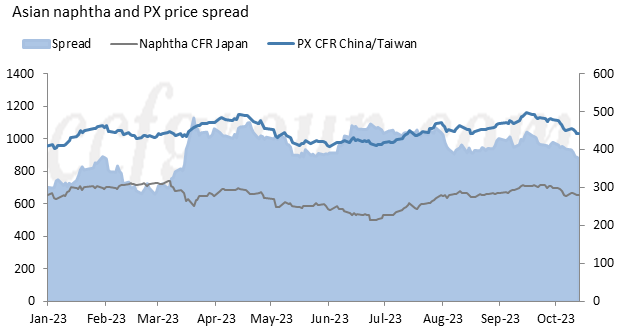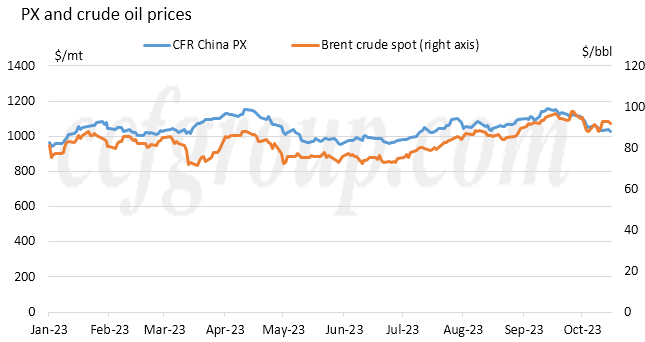PX-naphtha price spread squeezes amid weaker fundamentals
PX price has been slipping since mid-Sep. As of Oct 13, PX price has declined to $1033/mt CFR, down by 11% from the high point of $1160/mt CFR on Sep 15. And its spread to naphtha has squeezed from $447/mt to $376/mt over the same period.

The decline in crude oil weighed on PX market.

Crude oil price hiked persistently in Jul-Sep. Besides from OPEC+'s production cuts, surge in demand for gasoline during travelling peak was another driving force to crude oil. In early Oct, however, gasoline demand in the US waned rapidly, while gasoline stocks rose sharply from 5-year low. As a result, the support to crude oil diminished with gasoline price slumping. In the meantime, naphtha and PX prices declined in tandem. The squeeze in PX-naphtha spread was also attributed to weaker PX fundamentals.
China polyester plant operating rate has been hovering high, after reaching 93% in early Jun, which supported PTA plants to sustain high operating rate and ensured demand for PX despites that PTA processing margin was in negative territory in some periods. For some integrated plants, it was acceptable to offset the losses in PTA with PX-naphtha margin and polyester margin. In addition, in spite of the loss, PTA producers, in the need to maintain market shares, kept plants running.

In mid-Sep, polyester plant operating rate dropped by nearly 4 percentage points. Some PTA producers including Yisheng, Hengli and INEOS announced maintenance plans for their plants with combined capacity of 7.5 million mt/yr. In early Oct, Yisheng postponed the restart of its 3.6 million mt/yr PTA lines, and the average operating rate of PTA plants further dropped. As a result, demand for PX reduced, while PX supply was expected to be bounteous. Therefore, PX-naphtha spread kept squeezing, despite that PetroChina Guangdong and Shenghong unexpectedly cut PX plant operating rates.
During the past months when polyester operating rate was high, PTA plants, with insufficient feedstock, were heard frequently buying PX in the market. Buying were also heard from some PX suppliers and traders with the intention to push up average spot price. However, with several PTA plant announcing maintenance plans, some PTA producer was heard selling PX. Some PX suppliers was selling PX on RMB basis. Amid bounteous supply of Nov and Dec materials, some traders also suspended buying. In addition, some Japan-based trader only purchased 10,000 tons of PX prior to the port declaration. With buying intentions muted, and crude oil plunging, PX slumped and PX-naphtha spread got squeezed sharply.
Looking forward, crude oil price could be bolstered by the geopolitical conflict, as well as OPEC+'s commitment in supporting oil prices. Further downward space for oil price may be limited which could provide some support to PX.
As for the fundamentals of PX, supply growth is expected to outpace demand. On supply front, PetroChina Guangdong is recovering PX plant operating rate, Shenghong is also poised to raise operating rate, and CNPC Sichuan plans to restart its PX plant in Nov. Outside China, GS' 550kt/yr PX line in South Korea, NSRP's 700kt/yr unit in Vietnam and OMPL's 920kt/yr unit in India are expected to restart in Oct. In addition, TPPI's 780kt/yr plant and Satorp's 700kt/yr plant are anticipated to restart in Nov. As for PTA plants, Yisheng, Hengli and INEOS are undergoing maintenance, while the startup of Yisheng Hainan's new plant and the restart of Hanbang's old plant may could not absorb the increase in PX supply. Therefore, China PX inventory is expected to increase in Oct and Nov. In addition, after gasoline blending demand weakens, some TDP units may recover the run rates, which could lead to further increase in PX operating rate. As a result, any rise in PX price could be capped and it would be difficult for PX-naphtha spread to rebound to $400/mt, however, if the selloffs continue, the spread may drop below $350/mt.
- Top keywords
- Cotton Price
- Cotton Futures Price
- Cotton Futures
- CZCE
- PTA Futures Price
- Chemical Fiber
- Polyester Prices
- Wool price
- PTA Futures
- Shengze Silk
- China
- Yarn Price
- price
- China Textile City
- Fibre Price
- Benzene Price
- Cotton
- Index
- Cotton Index
- PTA
- fabric price
- NYMEX
- Top 10
- textile industry
- Spot Cotton
- Cotton Yarn
- Polyester Price
- Futures
- PTA Price
- cotton yarn price

